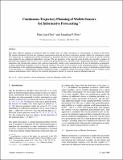Continuous Trajectory Planning of Mobile Sensors for Informative Forecasting
Author(s)
Choi, Han-Lim; How, Jonathan P.
DownloadChoi_ContinuousTrajectory.pdf (332.2Kb)
PUBLISHER_POLICY
Publisher Policy
Article is made available in accordance with the publisher's policy and may be subject to US copyright law. Please refer to the publisher's site for terms of use.
Terms of use
Metadata
Show full item recordAbstract
This paper addresses planning of continuous paths for mobile sensors to reduce uncertainty in some quantities of interest in the future.
The mutual information between the continuous measurement path and the future verification variables defines the information reward.
Two expressions for computing this mutual information are presented: the filter form extended from the state-of-the-art and the smoother
form inspired by the conditional independence structure. The key properties of the approach using the filter and smoother strategies are
presented and compared. The smoother form is shown to be preferable because it provides better computational efficiency, facilitates easy
integration with existing path synthesis tools, and most importantly, enables correct quantification of the rate of information accumulation.
A spatial interpolation technique is used to relate the motion of the sensor to the evolution of the measurement matrix, which leads to
the formulation of the optimal path planning problem. A gradient-ascent steering law based on the concept of information potential field
is also presented as a computationally efficient suboptimal strategy. A simplified weather forecasting example is used to compare several
planning methodologies and to illustrate the potential performance benefits of using the proposed planning approach.
Date issued
2010-06Department
Massachusetts Institute of Technology. Department of Aeronautics and AstronauticsCitation
Choi, Han-Lim and Jonathan P. How. "Continuous Trajectory Planning of Mobile Sensors for Informative Forecasting." (2009). Automatica 46 (2010) 1266-1275.
Version: Original manuscript
Keywords
sensor networks, mutual information, trajectory planning, mobile robots